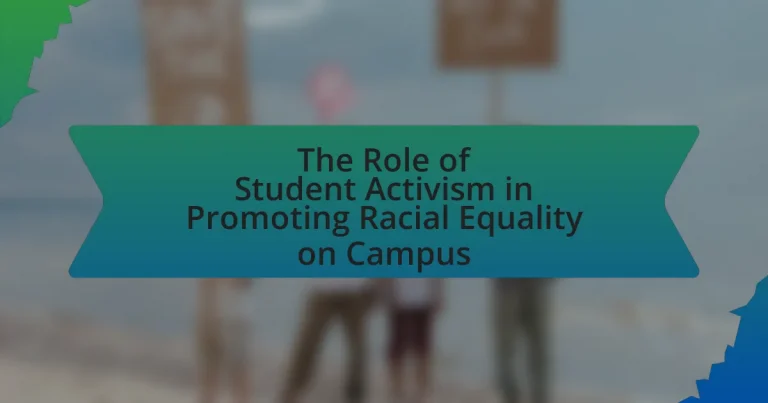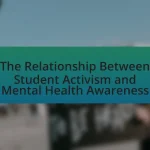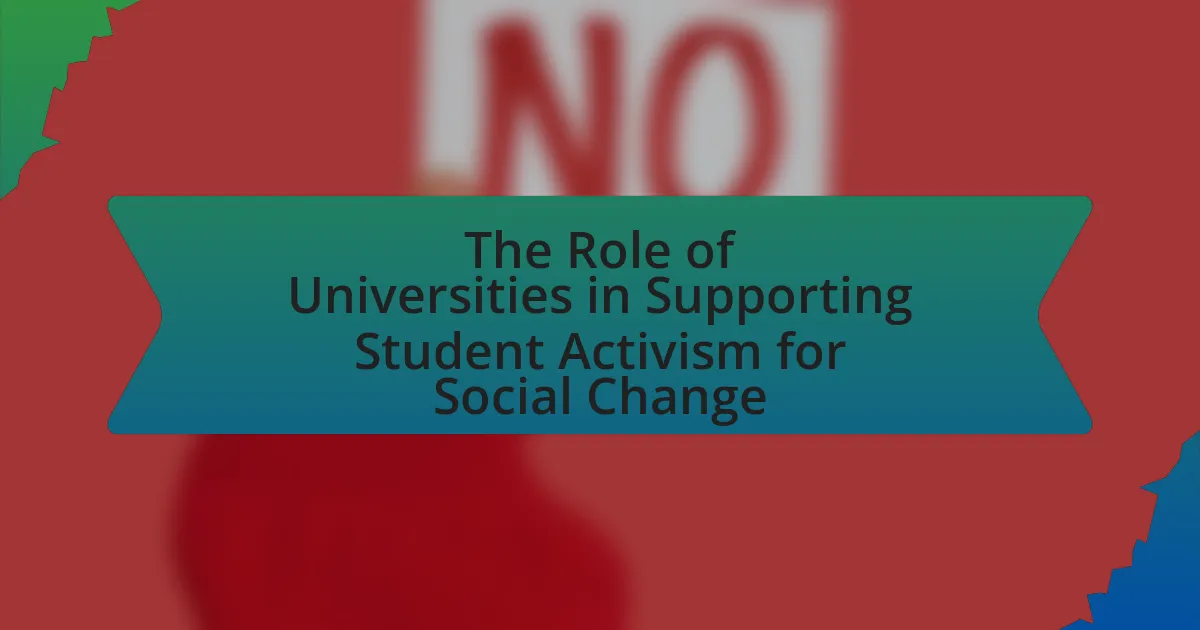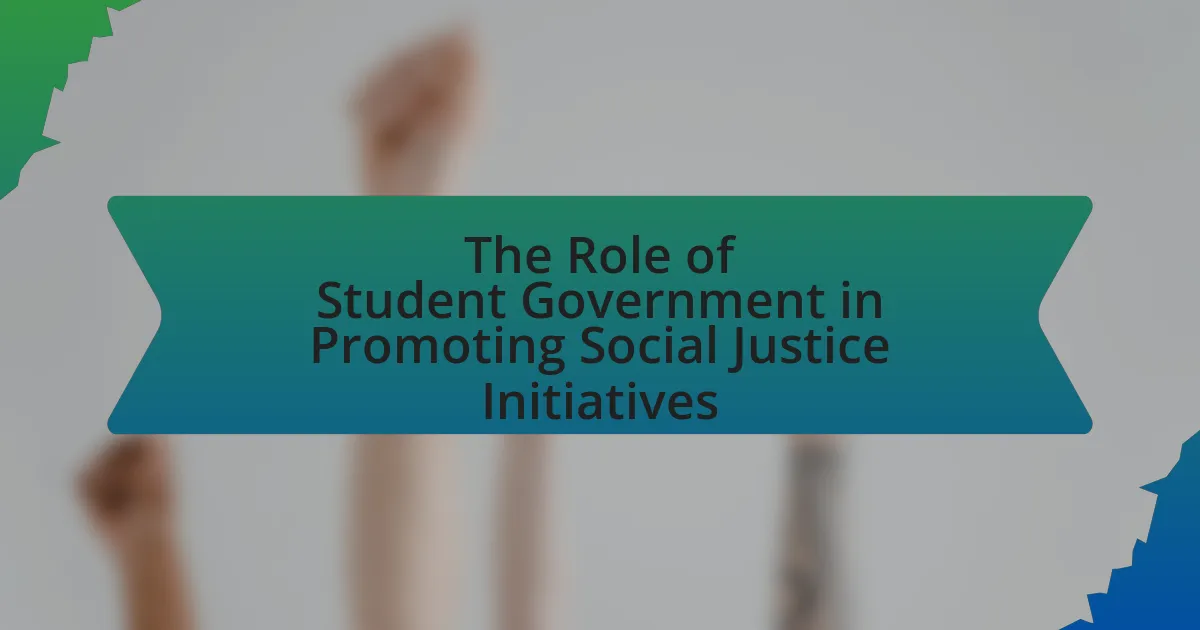Student activism is a vital force in promoting racial equality on college campuses, mobilizing students to advocate for systemic changes and raise awareness about racial injustices. Historically, movements such as the Civil Rights Movement and contemporary initiatives like Black Lives Matter have significantly influenced institutional policies, leading to the implementation of diversity training and inclusive curricula. Key events and student organizations have played crucial roles in advancing these efforts, while challenges such as institutional resistance and social backlash persist. The article explores the impact of student activism on campus culture, the importance of intersectionality, and effective strategies for mobilization, highlighting the ongoing relevance of student-led initiatives in the fight for racial equality.
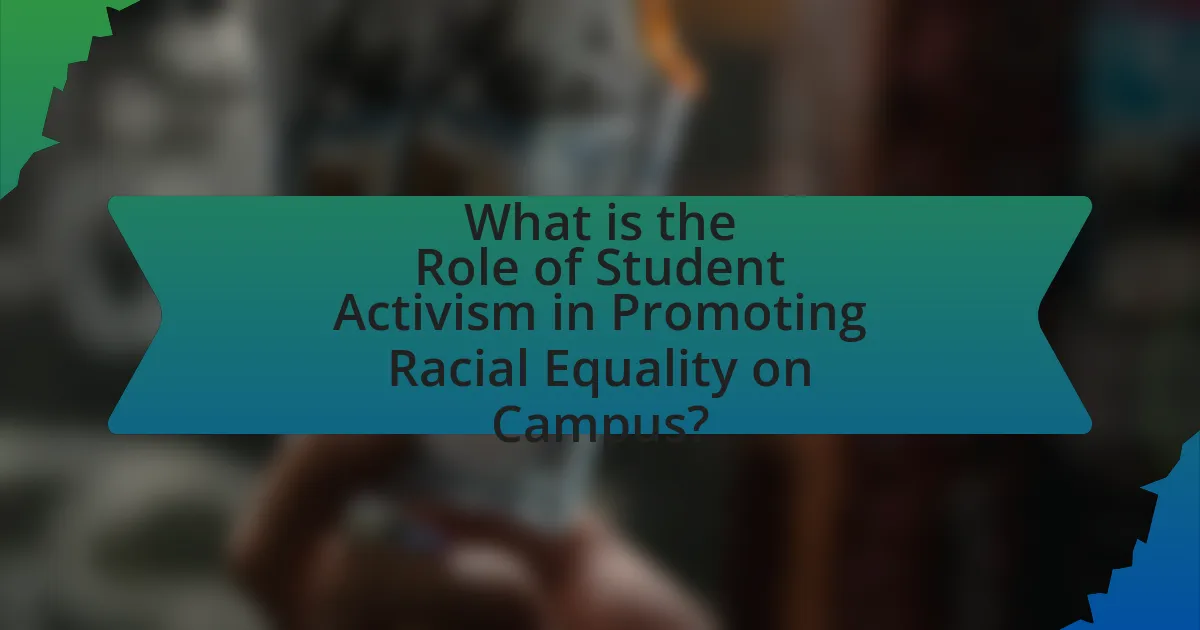
What is the Role of Student Activism in Promoting Racial Equality on Campus?
Student activism plays a crucial role in promoting racial equality on campus by mobilizing students to advocate for systemic changes and raise awareness about racial injustices. Through organized protests, campaigns, and dialogues, student activists challenge discriminatory practices and policies within educational institutions. For instance, movements like Black Lives Matter on campuses have successfully pushed for the implementation of diversity training and the establishment of inclusive curricula, which are essential for fostering an equitable environment. Additionally, research indicates that student-led initiatives can lead to significant policy changes, such as the creation of diversity offices and the hiring of more faculty from underrepresented backgrounds, thereby enhancing racial equality on campus.
How has student activism historically influenced racial equality on campuses?
Student activism has historically played a crucial role in advancing racial equality on campuses by mobilizing collective action and raising awareness about systemic injustices. For instance, the Civil Rights Movement of the 1960s saw students organizing protests, sit-ins, and marches, which pressured universities to adopt more inclusive policies and practices. Notably, the Student Nonviolent Coordinating Committee (SNCC) was instrumental in advocating for desegregation in higher education, leading to significant changes in admissions policies at institutions like the University of Alabama. Additionally, the Black Student Union at San Francisco State University successfully fought for the establishment of Black Studies programs, which contributed to a broader understanding of racial issues and the importance of representation in academia. These historical examples demonstrate that student activism has been a powerful catalyst for promoting racial equality on campuses.
What key events have marked significant moments in student activism for racial equality?
Key events that have marked significant moments in student activism for racial equality include the 1960 Greensboro sit-ins, the 1968 San Francisco State University strike, and the 2015 #BlackLivesMatter protests on college campuses. The Greensboro sit-ins involved four African American students who protested segregated lunch counters, leading to widespread sit-ins across the South and contributing to the Civil Rights Movement. The San Francisco State University strike was a pivotal moment for ethnic studies, where students demanded a curriculum that reflected their diverse backgrounds, resulting in the establishment of the first College of Ethnic Studies in the U.S. The 2015 #BlackLivesMatter protests on campuses highlighted ongoing racial injustices and mobilized students nationwide to advocate for policy changes and greater representation. These events collectively illustrate the critical role of student activism in advancing racial equality.
How have different student organizations contributed to this movement?
Different student organizations have significantly contributed to the movement for racial equality on campus by mobilizing students, raising awareness, and advocating for policy changes. For instance, organizations such as the Black Student Union and other multicultural groups have organized protests, educational workshops, and discussions that highlight racial injustices, fostering a sense of community and solidarity among students. These organizations have also collaborated with faculty and administration to implement diversity training programs and promote inclusive curricula, which are essential for creating a more equitable campus environment. Evidence of their impact can be seen in increased enrollment of students from diverse backgrounds and the establishment of diversity offices at many universities, reflecting the effectiveness of student-led initiatives in driving institutional change.
Why is student activism essential for promoting racial equality on campus?
Student activism is essential for promoting racial equality on campus because it mobilizes collective action and raises awareness about systemic injustices. Through organized protests, campaigns, and dialogues, students can challenge discriminatory practices and advocate for policy changes that foster inclusivity. Historical examples, such as the Civil Rights Movement, demonstrate how student-led initiatives have effectively influenced legislation and societal attitudes, highlighting the power of youth engagement in driving social change. Additionally, research indicates that campuses with active student organizations focused on racial equality report higher levels of awareness and support for diversity initiatives, reinforcing the impact of activism in creating equitable educational environments.
What unique perspectives do students bring to the conversation on racial equality?
Students bring diverse and fresh perspectives to the conversation on racial equality, shaped by their unique backgrounds, experiences, and educational environments. Their engagement often reflects a blend of personal narratives and collective experiences, highlighting issues such as systemic racism, privilege, and intersectionality. For instance, students from marginalized communities may share firsthand accounts of discrimination, while those from more privileged backgrounds can offer insights into the importance of allyship and advocacy. Research indicates that student activism has historically played a crucial role in advancing civil rights, as seen during the Civil Rights Movement when student-led organizations like SNCC mobilized youth to challenge racial injustices. This historical context underscores the significance of student voices in shaping contemporary discussions on racial equality.
How does student activism impact institutional policies regarding racial equality?
Student activism significantly influences institutional policies regarding racial equality by raising awareness and demanding accountability from educational institutions. Through organized protests, petitions, and advocacy campaigns, students highlight systemic inequalities and push for reforms such as inclusive curricula, diversity hiring practices, and equitable disciplinary measures. For instance, the Black Lives Matter movement on campuses has led to policy changes at universities like the University of California, which adopted new guidelines for addressing racial bias and enhancing support for marginalized students. This demonstrates that student activism not only brings attention to issues of racial inequality but also compels institutions to implement concrete policy changes in response to student demands.
What challenges do student activists face in promoting racial equality?
Student activists face significant challenges in promoting racial equality, including institutional resistance, lack of resources, and social backlash. Institutional resistance often manifests as administrative pushback against proposed changes, limiting the effectiveness of student-led initiatives. Additionally, many student activists operate with limited funding and support, which hampers their ability to organize events and campaigns. Social backlash can include harassment or ostracism from peers who oppose their views, creating a hostile environment that discourages activism. These challenges are documented in studies such as “Student Activism and Racial Justice” by the American Council on Education, which highlights the obstacles faced by student groups advocating for racial equity on campuses.
How do institutional resistance and societal pressures affect student activism?
Institutional resistance and societal pressures significantly hinder student activism by creating barriers to mobilization and expression. Institutional resistance manifests through policies that limit free speech, restrict protests, or impose disciplinary actions against activists, which can discourage participation. For example, universities may enforce regulations that require permits for demonstrations, thereby complicating the organization of events aimed at promoting racial equality. Societal pressures, such as public opinion or media portrayal, can further impact student activism by either galvanizing support or fostering backlash against movements. Research indicates that when societal attitudes are unfavorable, students may feel isolated or fearful of repercussions, which can stifle their willingness to engage in activism. Thus, both institutional and societal factors play critical roles in shaping the landscape of student activism, often determining its effectiveness and reach.
What role does intersectionality play in the challenges faced by student activists?
Intersectionality significantly complicates the challenges faced by student activists by highlighting how overlapping social identities, such as race, gender, and socioeconomic status, create unique experiences of oppression. For instance, a Black female student may encounter both racial and gender discrimination, which can amplify the difficulties in mobilizing support and addressing issues on campus. Research by Crenshaw (1989) emphasizes that traditional activism often overlooks these intersecting identities, leading to inadequate representation and support for marginalized groups. This lack of recognition can hinder the effectiveness of student activism aimed at promoting racial equality, as it may fail to address the specific needs and perspectives of those who experience multiple forms of discrimination.
How can student activism effectively promote racial equality on campus?
Student activism can effectively promote racial equality on campus by organizing awareness campaigns, advocating for policy changes, and fostering inclusive dialogues. These actions mobilize the student body, raise awareness about racial injustices, and create pressure on university administrations to implement equitable policies. For instance, the Black Lives Matter movement on campuses has led to significant policy changes, such as the establishment of diversity and inclusion offices and the implementation of anti-racism training programs. Research from the American Council on Education indicates that institutions with active student organizations focused on racial equality report higher levels of student engagement and satisfaction, demonstrating the impact of activism on fostering a more equitable campus environment.
What strategies have proven successful in mobilizing student activism for racial equality?
Successful strategies for mobilizing student activism for racial equality include grassroots organizing, coalition-building, and leveraging social media. Grassroots organizing empowers students to take initiative, often leading to local actions such as protests and sit-ins, which have historically proven effective, as seen in the Civil Rights Movement. Coalition-building with diverse student groups amplifies voices and resources, fostering a united front; for example, the Black Lives Matter movement on campuses has successfully united various organizations to advocate for systemic change. Additionally, social media serves as a powerful tool for awareness and mobilization, enabling rapid dissemination of information and coordination of events, evidenced by the widespread participation in online campaigns like #BlackLivesMatter, which has engaged millions of students globally.
How can collaboration with faculty and administration enhance student activism efforts?
Collaboration with faculty and administration can significantly enhance student activism efforts by providing essential resources, mentorship, and institutional support. Faculty members can offer expertise and guidance on effective advocacy strategies, while administration can facilitate access to funding, venues, and communication channels. For instance, when faculty and administration work together with student groups, they can create structured platforms for dialogue, such as forums or workshops, which amplify student voices and concerns. Research indicates that campuses with strong faculty-administration-student partnerships see increased participation in activism and more successful outcomes in initiatives aimed at promoting racial equality. This collaborative approach not only legitimizes student efforts but also fosters a more inclusive campus environment, ultimately leading to meaningful change.
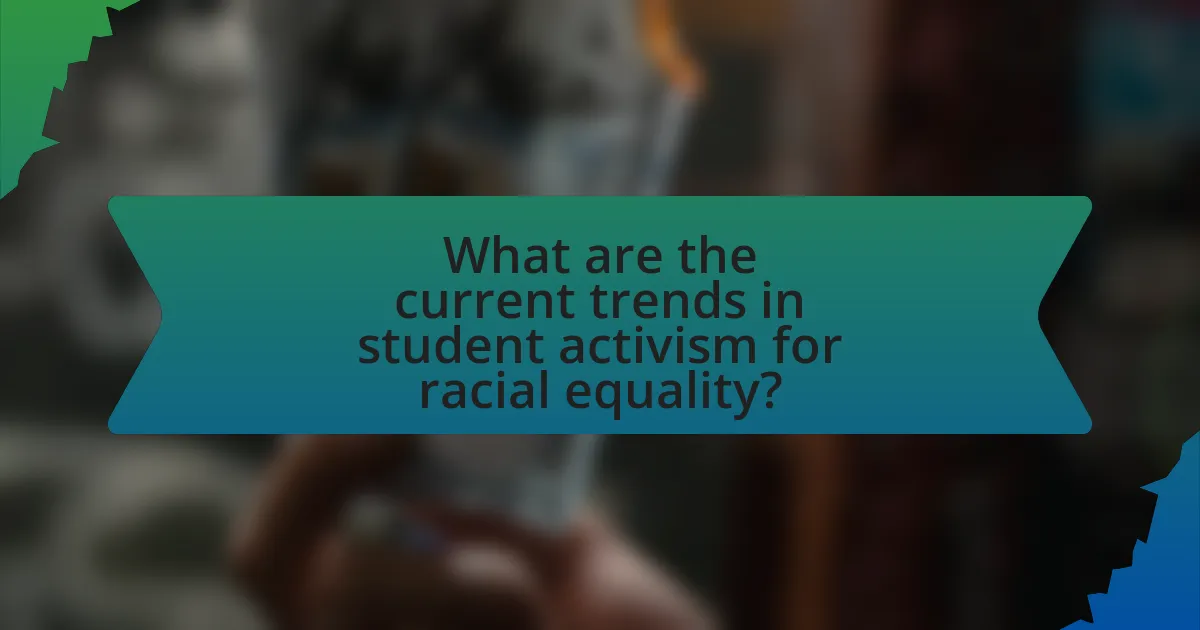
What are the current trends in student activism for racial equality?
Current trends in student activism for racial equality include increased use of social media platforms for organizing and raising awareness, a focus on intersectionality in racial justice movements, and the establishment of coalitions among diverse student groups. Social media enables rapid mobilization and the sharing of information, as seen in campaigns like #BlackLivesMatter, which have gained significant traction among students. Additionally, students are increasingly addressing the interconnectedness of various social justice issues, advocating for policies that consider race, gender, and socioeconomic status. Furthermore, many universities are witnessing the formation of coalitions that unite different racial and ethnic groups to amplify their voices and demands for systemic change, reflecting a broader understanding of racial equality as a collective struggle.
How has social media changed the landscape of student activism?
Social media has transformed student activism by providing a platform for rapid communication and mobilization. This shift allows students to organize protests, share information, and amplify their voices on issues related to racial equality more effectively than traditional methods. For instance, the #BlackLivesMatter movement gained significant traction through social media, enabling students to connect with broader networks and raise awareness about racial injustices on campuses. Additionally, studies indicate that social media campaigns can lead to increased participation in activism, as seen in the 2018 March for Our Lives, where students utilized platforms like Twitter and Instagram to coordinate events and engage supporters.
What platforms are most effective for student activists in raising awareness?
Social media platforms, particularly Instagram, Twitter, and TikTok, are most effective for student activists in raising awareness. These platforms enable rapid dissemination of information, visual storytelling, and engagement with a broad audience. For instance, a study by the Pew Research Center found that 69% of adults aged 18-29 use Instagram, making it a vital tool for reaching younger demographics. Additionally, Twitter’s real-time communication allows activists to mobilize support quickly, as evidenced by the #BlackLivesMatter movement, which gained significant traction through tweets and hashtags. TikTok’s short video format has also proven effective in creating viral content that raises awareness about racial equality issues among students.
How do online campaigns translate into real-world actions for racial equality?
Online campaigns translate into real-world actions for racial equality by mobilizing individuals, raising awareness, and influencing policy changes. These campaigns often utilize social media platforms to disseminate information rapidly, engage communities, and organize protests or events that demand systemic change. For instance, the Black Lives Matter movement, which gained momentum through online activism, led to significant protests and discussions around police reform and racial justice, resulting in legislative proposals in various states. Research indicates that social media activism can increase participation in offline events, as seen in studies showing that online engagement correlates with higher turnout at rallies and community meetings focused on racial equality.
What role do intersectional identities play in contemporary student activism?
Intersectional identities significantly shape contemporary student activism by highlighting the interconnectedness of various social categories such as race, gender, sexuality, and class. This complexity allows activists to address multiple forms of discrimination and advocate for more inclusive policies. For instance, the Black Lives Matter movement, which emerged from student activism, emphasizes how racial injustice intersects with issues like gender and economic inequality, thereby fostering a broader understanding of systemic oppression. Research by Crenshaw (1989) on intersectionality illustrates that individuals experience overlapping identities that influence their social experiences and activism, reinforcing the need for a multifaceted approach in advocating for racial equality on campus.
How do race, gender, and class intersect in the context of student activism?
Race, gender, and class intersect in student activism by shaping the experiences and priorities of activists, influencing the issues they address and the strategies they employ. For instance, students from marginalized racial backgrounds often face unique challenges that are compounded by their gender and socioeconomic status, leading to a multifaceted approach to activism that seeks to address systemic inequalities. Research indicates that Black women, for example, experience both racial and gender discrimination, which informs their activism around issues like police brutality and campus safety, as highlighted in the work of scholars such as Kimberlé Crenshaw, who coined the term “intersectionality.” This intersectional lens allows student activists to advocate for policies that consider the diverse needs of their communities, ultimately promoting a more inclusive approach to racial equality on campus.
What are the implications of intersectionality for coalition-building among student groups?
Intersectionality significantly impacts coalition-building among student groups by highlighting the diverse identities and experiences that shape individuals’ social realities. This framework encourages student organizations to recognize and address overlapping systems of oppression, such as race, gender, sexuality, and class, which can lead to more inclusive and effective alliances. For instance, research by Crenshaw (1989) emphasizes that understanding these intersections allows groups to advocate for policies that reflect the needs of all members, rather than a singular narrative. Consequently, intersectionality fosters solidarity among student groups, enabling them to unite around shared goals while respecting their unique challenges, ultimately enhancing their collective power in promoting racial equality on campus.
What impact does student activism have on campus culture regarding racial equality?
Student activism significantly enhances campus culture regarding racial equality by fostering awareness, promoting dialogue, and driving institutional change. Activism initiatives, such as protests and awareness campaigns, often lead to increased visibility of racial issues, encouraging students and faculty to engage in discussions about systemic racism and inequality. For instance, the Black Lives Matter movement on campuses has resulted in policy changes, such as the implementation of diversity training programs and the establishment of resource centers for marginalized students. Research indicates that campuses with active student organizations advocating for racial equality report higher levels of inclusivity and support for diverse student populations, demonstrating a direct correlation between activism and improved campus culture.
How does student activism influence the attitudes of the broader student body?
Student activism significantly influences the attitudes of the broader student body by raising awareness and fostering dialogue around social issues, particularly racial equality. When student activists organize events, protests, or campaigns, they often highlight injustices and mobilize peers to engage in discussions that challenge existing norms and beliefs. For instance, the Black Lives Matter movement on campuses has led to increased participation in conversations about systemic racism, resulting in a more informed and empathetic student population. Research indicates that campuses with active student organizations advocating for racial equality report higher levels of student engagement and solidarity, demonstrating that activism can shift collective attitudes towards inclusivity and social justice.
What long-term changes can be observed in campus culture due to student activism?
Long-term changes in campus culture due to student activism include increased awareness and dialogue surrounding racial equality, the establishment of more inclusive policies, and the creation of diverse student organizations. These changes are evidenced by the implementation of diversity training programs and the formation of multicultural centers on campuses following significant student-led movements, such as the Black Lives Matter protests in 2014, which prompted universities to reevaluate their approaches to diversity and inclusion. Additionally, research from the American Council on Education indicates that institutions with active student organizations advocating for racial equality report higher levels of student engagement and satisfaction, demonstrating a lasting impact on campus culture.
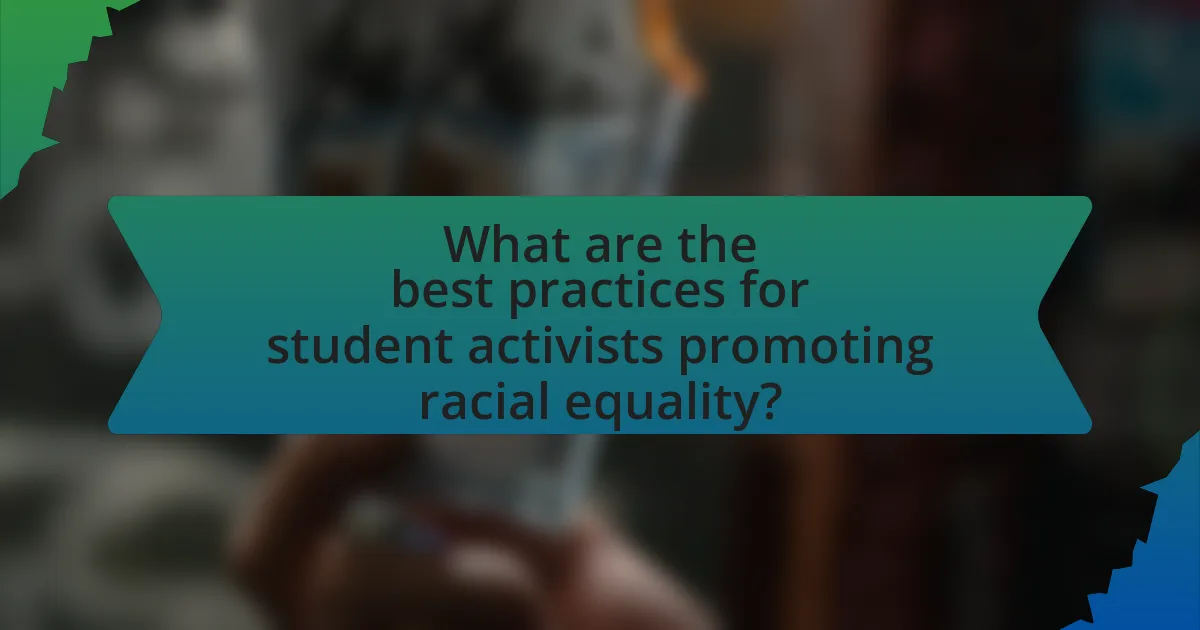
What are the best practices for student activists promoting racial equality?
Student activists promoting racial equality should prioritize education, coalition-building, and strategic advocacy. Education involves raising awareness about racial issues through workshops, discussions, and informational campaigns, which can lead to a more informed student body. Coalition-building with diverse groups enhances solidarity and amplifies voices, as seen in successful movements like the Civil Rights Movement, where unity among various organizations was crucial. Strategic advocacy includes organizing peaceful protests, engaging with university administration, and utilizing social media to reach a broader audience, which has proven effective in mobilizing support and driving change. These practices are supported by historical evidence showing that organized, informed, and united efforts lead to significant advancements in racial equality.
How can student activists effectively organize and mobilize their peers?
Student activists can effectively organize and mobilize their peers by utilizing social media platforms to disseminate information and create a sense of community. Research indicates that 79% of college students use social media to connect with others, making it a powerful tool for outreach and engagement. By creating events, sharing educational content, and fostering discussions online, student activists can increase awareness and participation in racial equality initiatives on campus. Additionally, forming coalitions with existing organizations enhances visibility and resources, as collaboration can amplify their message and reach a broader audience.
What are the key components of a successful student-led campaign for racial equality?
A successful student-led campaign for racial equality includes clear objectives, strong leadership, community engagement, effective communication, and strategic partnerships. Clear objectives provide direction and measurable goals, such as increasing awareness or advocating for policy changes. Strong leadership is essential for mobilizing support and maintaining momentum, as seen in campaigns like the Black Lives Matter movement, which effectively organized student protests. Community engagement fosters inclusivity and broadens the campaign’s impact, as demonstrated by initiatives that involve diverse student groups. Effective communication ensures that the campaign’s message resonates with the audience, utilizing social media and traditional media to amplify reach. Strategic partnerships with local organizations and faculty can enhance resources and credibility, as evidenced by successful collaborations in various campus movements.
How can student activists ensure inclusivity in their movements?
Student activists can ensure inclusivity in their movements by actively engaging diverse voices and perspectives within their initiatives. This involves creating platforms for underrepresented groups to share their experiences and concerns, thereby fostering a sense of belonging and participation. Research indicates that inclusive movements are more effective; for instance, a study by the American Psychological Association found that diverse teams are 35% more likely to outperform their peers in problem-solving. By prioritizing representation and collaboration, student activists can build stronger coalitions that address the multifaceted nature of racial equality on campus.
What resources are available for student activists focused on racial equality?
Student activists focused on racial equality can access various resources, including organizations, online platforms, and educational materials. Notable organizations such as the NAACP and Black Lives Matter provide support, networking opportunities, and advocacy training. Online platforms like Change.org and social media channels facilitate awareness campaigns and mobilization efforts. Additionally, educational resources from institutions like the American Psychological Association offer research and guidelines on racial equity, helping activists understand systemic issues and effective strategies for change. These resources collectively empower student activists to effectively promote racial equality on campus.
What organizations provide support and guidance for student activists?
Organizations that provide support and guidance for student activists include the Student Nonviolent Coordinating Committee (SNCC), the American Civil Liberties Union (ACLU), and the National Association for the Advancement of Colored People (NAACP). These organizations have historically played significant roles in advocating for civil rights and providing resources for student-led initiatives. For instance, SNCC was pivotal during the Civil Rights Movement, empowering students to engage in activism, while the ACLU offers legal support and educational resources to protect civil liberties. The NAACP provides a platform for students to connect with broader civil rights efforts and access mentorship and training programs.
How can students access training and educational materials on activism?
Students can access training and educational materials on activism through various online platforms, university resources, and community organizations. Online platforms such as Coursera and edX offer courses specifically focused on activism and social justice, while universities often provide workshops and seminars that cover activism strategies and racial equality issues. Additionally, organizations like the American Civil Liberties Union (ACLU) and the NAACP offer resources and training materials that students can utilize to enhance their understanding and skills in activism. These resources are designed to equip students with the knowledge necessary to effectively engage in activism and promote racial equality on campus.
What are the next steps for student activists in promoting racial equality on campus?
Student activists should focus on organizing inclusive dialogues and workshops to educate peers about racial equality. These initiatives can foster understanding and solidarity among diverse student groups. Additionally, activists should collaborate with university administration to implement policy changes that address systemic inequalities, such as revising admissions processes and enhancing support services for marginalized students. Evidence shows that institutions with active student engagement in policy-making see improved campus climates and increased diversity (American Council on Education, 2020). By leveraging social media campaigns, activists can raise awareness and mobilize support for racial equality initiatives, amplifying their impact across campus.
How can students sustain momentum in their activism efforts over time?
Students can sustain momentum in their activism efforts over time by establishing clear goals, fostering community engagement, and utilizing digital platforms for outreach. Setting specific, measurable objectives helps maintain focus and direction, while engaging with peers and local organizations builds a supportive network that encourages ongoing participation. Additionally, leveraging social media and online tools allows students to reach a broader audience, share updates, and mobilize support efficiently. Research indicates that sustained activism is often linked to strong community ties and effective communication strategies, which can enhance the impact of their efforts in promoting racial equality on campus.
What role can alumni play in supporting current student activism initiatives?
Alumni can play a crucial role in supporting current student activism initiatives by providing mentorship, funding, and networking opportunities. Their experience can guide students in organizing effective campaigns, while financial contributions can help sustain activism efforts, as seen in various universities where alumni donations have directly funded student-led initiatives. Additionally, alumni can leverage their professional networks to connect students with influential figures and organizations that can amplify their causes, thereby enhancing the impact of student activism on campus racial equality efforts.
